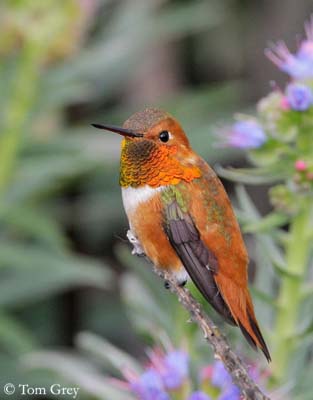
Rufous Hummingbird
Selasphorus rufus
Apodiforme Order – Trochilidae Family
BIOMETRICS:
Length : 7 à 9 cm
Wingspan : 11 cm
Weight : M : 3,22 g – F : 3,40 g
LONGEVITY: Up to 4 years
DESCRIPTION:
Rufous Hummingbird male has rufous face, back, flanks, rump and tail. Sometimes, crown and back may be marked with green. We can see bright orange-red gorget, with some elongated feathers extending far down sides of neck. Top of head is bronze-green. Chin and throat show a shiny metallic scarlet colour.
Fr: Colibri roux
All : Rotrücken – Zimtelfe
Esp : Colibrí Rufo
Ital : Colibri rossiccio
Nd : Rosse Kolibrie
Sd : Rostkolobri
Photographs by Tom Grey
His website:
Tom Grey's Bird Pictures
Photographs by Bob Moul
His website:
Nature Photography
Text by Nicole Bouglouan
Sources :
HANDBOOK OF THE BIRDS OF THE WORLD Vol 5 by Josep del Hoyo-Andrew Elliott-Jordi Sargatal - Lynx Edicions - ISBN: 8487334253
A GUIDE TO THE BIRDS OF MEXICO AND NORTHERN CENTRAL AMERICA by Steve N. G. Howell, Sophie Webb - Oxford University Press - ISBN: 0198540124
All About Birds (Cornell Lab of Ornithology)
Bird Web (Seattle Audubon Society)
Wikipedia (Wikipedia, The Free Encyclopedia)
What Bird-The ultimate Bird Guide (Mitchell Waite)

Tail has pointed orange feathers, with dark tips. Wings are dusky. Breast is white, but belly and undertail coverts are buffy.
Black bill is needle-shaped. Eyes are black with small white spot behind eye. Legs and feet are blackish.
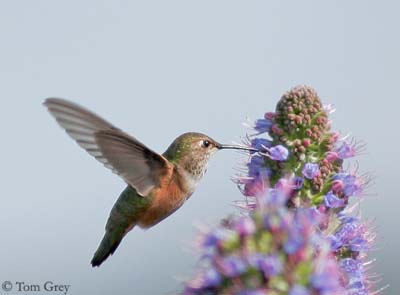
Female has iridescent bronze-green back. Head is slightly duller than in male. Sometimes, female has some varied patches of red feathers in the middle of the throat. She is slightly larger than male.
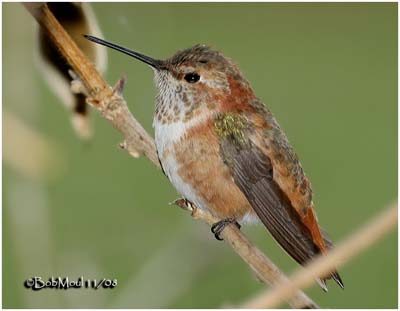
Immature male resembles female, with more rufous on rump and lower back. Immature female is similar to adult, but duller.
This species is very similar to Allen’s Hummingbird which female and immature are very difficult to identify in wild.
VOICE: SOUNDS BY XENO-CANTO
Rufous Hummingbird’s calls include a sharp “chip” given in series, and buzzy notes. We can also hear a buzzy wing whistle. Males are much more active vocally than females.
HABITAT:
Rufous Hummingbird lives in forests, brushy areas and high-mountain meadows.
During winter, it moves according to the food resources, and lives where flowers are present. It is found in oak forests with scattered conifers, brush and scrublands.
RANGE:
Rufous Hummingbird is found in western and coastal areas of North America, northwards through Canada into south eastern Alaska.
BEHAVIOUR:
Rufous Hummingbird feeds mainly on flower nectar, and this bird is more attracted by red and tubular flowers than others, because it needs space for its wing beats. It consumes nectar with its fork-like tongue.
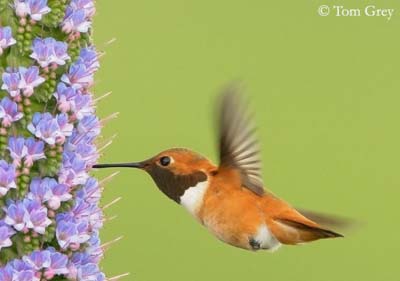
Rufous Hummingbird is highly territorial, even against members of its own species. It defends strongly territory and nectar resources. Feeding competitions occur where the birds are numerous at very few nectar resources. It also defends it in breeding season. It performs dives, chases, and kicks with claws to the intruder. They fight in midair. They may grasp each other, and then, they fall to the ground to get free.
Rufous Hummingbird travels over long distances in migrations, some thousands of km.
Rufous Hummingbird has a gland at the base of the tail, which oil is used to clean and waterproof its feathers. It likes to take sunbathes, fluffing out its feathers. It also takes bathes in water.
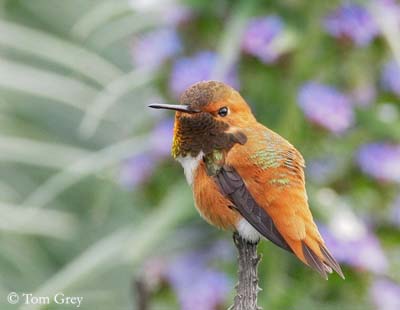
Male will mate with several females during breeding season. Courtship displays are spectacular. Male makes a series of steeps J-shaped, dives ending at the same point close to the female, but beginning at point following a circle. Dives are rapid but upwards movements are slower. While diving, the male utters a stuttering “dit-dit-dit-deeer” sound, and its wings create this unique metallic buzzing sound.
Sexes have separate territories. Female visits the male at mating time, and after, the male moves away.
Rufous Hummingbirds nest in colonies of up to 20 nests relatively close to each other.
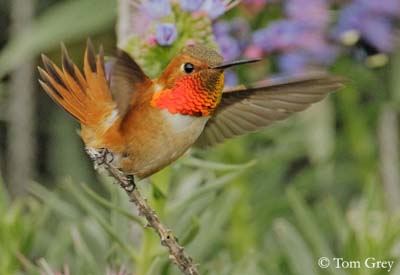
FLIGHT:
Rufous Hummingbird as other birds of this species is able to fly backwards. It hovers in front of the flower to sip the nectar.
REPRODUCTION:
Rufous Hummingbird female builds the nest in vines, bushes or other well protected overgrows. Nest is made with leaves, mosses, lichens and plant down, woven together with spider webs. Nest is a cover cup attached to a horizontal branch, at about 2 to 10 feet above the ground.
She lays 2 white eggs. Incubation lasts about 15 to 17 days, and young fledge one week later. They become independent at about 21 days. Female defends, incubates and takes care of chicks, while male doesn’t take part in raising young.
This species produces one brood per year, occasionally two.

DIET:
Rufous Hummingbird feeds mainly on flower nectar, but also sap from sapsucker wells, insects and spiders. It may consume up to three times its body weight per day.
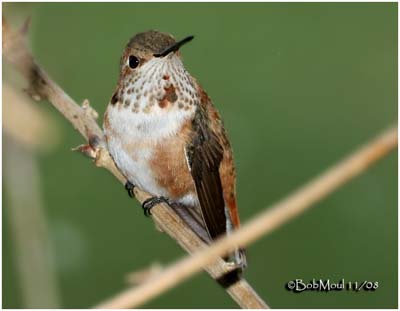
PROTECTION/ THREATS / STATUS:
Rufous Hummingbirds are common throughout their range.
Predators of this species include tiny hawks, merlins, owls and weasels. Sometimes, spiders may attack the Rufous Hummingbird.